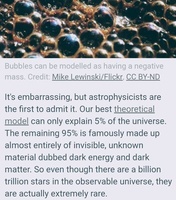Enjoy being online again!
Welcome to the community of good people who base their values on evidence and appreciate civil discourse - the social network you will enjoy.Create your free account
5 comments
Feel free to reply to any comment by clicking the "Reply" button.I think that's why it's called space..... it's mostly empty
Actually what both of these ideas imply is that space isn't empty! Particularly the dark energy idea.
My understanding is the current theory has to do with the filaments of matter around and between galaxies. It's basically matter we can't "see" directly because it's so diffuse, so appears to be non-baryonic, but is actually baryonic. I can't recall the exact stats and am at work right now, but this allegedly is actually able to account for a huge percentage of the remaining mass. Maybe someone can back me up or refute this.
JimG:
If the presence of dark matter was discovered by impossibly high rotational velocities of galaxis, wouldn't it have to be within those galaxies?
@JimG "Within" here is fairly subjective. The filaments aren't detectable because they're so diffuse that they don't affect or give off light. So if they're within or around a galaxy, since you calculate the gravity of a galaxy using absorption lines in the spectrum, the filaments might be there but still be completely invisible. Even if they're on the outside of the galaxy, they'll still add to the rotational velocity of the galaxy due to how gravity acts, at least from my understanding. Here are some notes, not related to the filament theory, but just on how the gravity is calculated.
[astronomynotes.com]
@JimG Was able to find this article which should help clear things up, pun intended I guess. :/
[forbes.com]
@JimG It is but it isn't concentrated at the core. There is however usually a black hole at the core of a typical galaxy. Dark matter is within and around large galaxies and is know to be present because the orbital speeds of stars far from the center of the galaxy don't slow as they would if the orbits were just around ordinary visible matter.
We are in the nascent period of the scientific age here.......
I'm not really sure what you mean by "Negative mass hypothesis". The 95% of the universe thing is true but perhaps a bit misleading. We don't really understand "dark energy" so we can't really say what it is or how it may act in the future. What we do know is that something appears to be needed to explain the structure of spacetime that we see in our universe. If we assume that GR (General Relativity) is basically correct on the large scale, then dark energy is the most significant factor in explaining the large scale structure of spacetime.
I personally favor the cosmological constant explanation which extends Einstein's GR. So if GR is right and there is a constant in the equations that underpins the acceleration of the expansion that we observe then some other stuff fits in an elegant way.
I suspect that we will soon solve the mystery of dark matter. My guess at the moment is that dark matter is one of the long sought super-symmetric partner particles. Within the physics community there are hints that something along these lines is on the threshold of discovery.
I am indeed really interested. I hope that the answer isn't some of the simpler ones that I have heard like "tired light" or something else that is sort of mundane - at least from the perspective of trying to understand the grand design of our universe. My colleague at work (also a physicist by education, as am I) suggested recently that a tired light hypothesis had recently gotten significant support and that the accelerated expansion might go away. I hope not! I want to see exotic physics which may hint at a deeper theory that would significantly further our understanding and our search for a TOE (Theory of Everything.)
Good stuff!
The idea itself has merit -- and it makes "impossible" things like a perpetual motion machine or even a Warp Drive easier to construct... At the same time, it presents problems like runaway motion that need addressed before the idea is compatible with "normal" Newtonian physics.
Enjoy being online again!
Welcome to the community of good people who base their values on evidence and appreciate civil discourse - the social network you will enjoy.Create your free account
Share this post
Categories
Agnostic does not evaluate or guarantee the accuracy of any content. Read full disclaimer.








